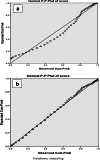Importance of livestock diseases identified using participatory epidemiology in the highlands of Ethiopia
- PMID: 31898026
- PMCID: PMC7858201
- DOI: 10.1007/s11250-019-02187-4
Importance of livestock diseases identified using participatory epidemiology in the highlands of Ethiopia
Erratum in
-
Correction to: Importance of livestock diseases identified using participatory epidemiology in the highlands of Ethiopia.Trop Anim Health Prod. 2021 Feb 17;53(1):171. doi: 10.1007/s11250-021-02593-7. Trop Anim Health Prod. 2021. PMID: 33595741 Free PMC article. No abstract available.
Abstract
Livestock are a major cornerstone for livelihoods of smallholders in the highlands of Ethiopia. However, infectious diseases are a key constraint in livestock production affecting productivity and food security. This study aimed to understand livestock producers' perception on importance and epidemiology of livestock diseases. Participatory tools using focus group discussions were used to identify and rank livestock species, major livestock diseases, and their epidemiological patterns in smallholder systems. The study covered 17 districts in four regions, with two or three kebeles (smallest administrative unit) included in each district. To capture views of women and men, separate focus group discussions (FGD) were conducted. Data collected through proportional piling were used in generalized linear model analysis. Taking sheep as a reference, cattle were significantly the most preferred species with the odds of cattle scoring higher than sheep being 2.08 times (P = 0.000). Sheep and poultry were equally the second most important livestock, followed by goat and equine. There were no statistically significant differences between men and women FGD groups and between the four regions in their preference for livestock species. Twelve out of 28 identified livestock diseases were mentioned by at least 10% of FGDs in their list of five most important diseases. Blackleg, foot, and mouth disease, lumpy skin disease, anthrax, and bovine pasteurellosis were ranked as the top five diseases by both men and women focus groups. Reasons for high scores included suddenness of death, zoonosis risks, animal age groups and species affected, frequency of occurrence, rate of transmission in herds, curability, and inefficient vaccination. Seasonality and agro-ecology were also factors associated with disease occurrence. The study also documents that adult men and women are more involved in activities related to disease transmission compared with other family members. When asked about impacts of diseases, loss of livelihood, displacement, and infection with zoonoses were mentioned, with women considered equally affected as men. In conclusion, participatory tools allowed understanding disease priorities of and their perceived epidemiology in smallholder systems. The perceptions and priorities of men and women are very similar, and both need to be involved in designing health management interventions. Based on the findings of this study, the intervention strategies listed in the 2013 animal health strategy of Ethiopia (MoA and ILRI 2013) seem pertinent and need to be implemented to overcome the challenges of diseases.
Keywords: Diseases; Gender; Livestock; Participatory epidemiology; Smallholders.
Figures




Similar articles
-
Application of Mixed Methods to Identify Small Ruminant Disease Priorities in Ethiopia.Front Vet Sci. 2019 Nov 26;6:417. doi: 10.3389/fvets.2019.00417. eCollection 2019. Front Vet Sci. 2019. PMID: 32039243 Free PMC article.
-
A community-based participatory study investigating the epidemiology and effects of rabies to livestock owners in rural Ethiopia.Prev Vet Med. 2013 Jan 1;108(1):1-9. doi: 10.1016/j.prevetmed.2012.07.003. Epub 2012 Aug 11. Prev Vet Med. 2013. PMID: 22884728
-
Management of diseases in a ruminant livestock production system: a participatory appraisal of the performance of veterinary services delivery, and utilization in Ghana.BMC Vet Res. 2023 Nov 15;19(1):237. doi: 10.1186/s12917-023-03793-z. BMC Vet Res. 2023. PMID: 37968624 Free PMC article.
-
Improving Smallholder Farmer Biosecurity in the Mekong Region Through Change Management.Transbound Emerg Dis. 2015 Oct;62(5):491-504. doi: 10.1111/tbed.12181. Epub 2013 Nov 8. Transbound Emerg Dis. 2015. PMID: 26302253 Review.
-
The economics of optimal health and productivity in smallholder livestock systems in developing countries.Rev Sci Tech. 1999 Aug;18(2):399-424. doi: 10.20506/rst.18.2.1167. Rev Sci Tech. 1999. PMID: 10472676 Review.
Cited by
-
Extension Services for Livestock Keepers in Low-Income Countries-A Low Priority?Animals (Basel). 2022 Mar 14;12(6):726. doi: 10.3390/ani12060726. Animals (Basel). 2022. PMID: 35327123 Free PMC article.
-
Animal Health Service Delivery in Crop-Livestock and Pastoral Systems in Ethiopia.Front Vet Sci. 2021 Jun 7;8:601878. doi: 10.3389/fvets.2021.601878. eCollection 2021. Front Vet Sci. 2021. PMID: 34164445 Free PMC article.
-
One hundred years of zoonoses research in the Horn of Africa: A scoping review.PLoS Negl Trop Dis. 2021 Jul 16;15(7):e0009607. doi: 10.1371/journal.pntd.0009607. eCollection 2021 Jul. PLoS Negl Trop Dis. 2021. PMID: 34270551 Free PMC article.
-
Fowl Cholera in Chickens: Current Trends in Diagnosis and Phenotypic Drug Resistance in Gondar City, Ethiopia.Vet Med Int. 2024 Dec 5;2024:6613019. doi: 10.1155/vmi/6613019. eCollection 2024. Vet Med Int. 2024. PMID: 39669206 Free PMC article. Review.
-
Relationship between animal health and livestock farmers' wellbeing in Ghana: beyond zoonoses.BMC Public Health. 2023 Jul 14;23(1):1353. doi: 10.1186/s12889-023-16287-2. BMC Public Health. 2023. PMID: 37452274 Free PMC article.
References
-
- Abeyasekera, S., 2001. Analysis approaches in participatory work involving ranks or scores. Statistical Services Centre, The University of Reading. https://www.reading.ac.uk/ssc/resources/AnalysisApproachesInParticipator.... (Accessed May 2017).
-
- Agresti A. An introduction to categorical data analysis. New York: Wiley; 1996.
-
- Aklilu, Y., Little, P.D., Mahmoud, H. and McPeak, J., 2013. Market access and trade issues affecting the dry lands in the Horn of Africa. Brief prepared by a Technical Consortium hosted by CGIAR in partnership with the FAO Investment Centre. Technical Consortium Brief 2. Nairobi: International Livestock Research Institute.
-
- Albe, A., Feyera, T., and Gebeyew, K. 2016. Major animal health constraints of market-oriented livestock development in Sidama Dale district southern region Ethiopia. J Vet Sci Technol, 7:5.
MeSH terms
LinkOut - more resources
Full Text Sources

